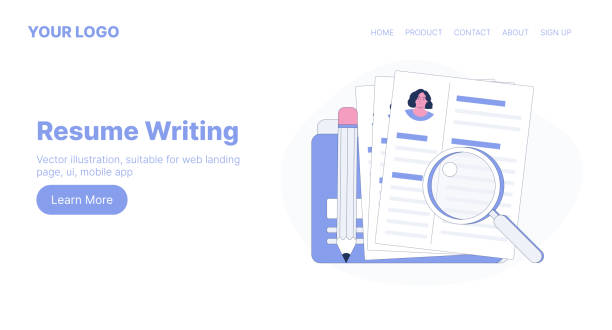Introduction to the Importance of User-Friendly Website Design

In today’s digital world, having a website is not just about having an online presence; it must be a site that meets users’ needs and provides them with an enjoyable experience.
#UserFriendlyWebsiteDesign is more than a feature; it’s a necessity.
This approach ensures that your visitors can easily access the information they need, interact with the site, and ultimately achieve their goals, whether it’s purchasing a product, finding information, or making contact.
A poor design can lead to high bounce rates and lost potential customers, while user-friendly website design not only retains users but also significantly helps increase conversion rates and loyalty.
This concept includes not only visual appeal but also ease of navigation, loading speed, compatibility with various devices, and accessibility for everyone.
In this article, we will provide a comprehensive explanation of various aspects of successful website design to guide you on the path to creating an outstanding online experience.
Understanding these educational principles is essential to compete and stand out in the digital market.
For businesses looking to grow and develop, investing in website design that is specifically optimized for users will yield significant returns and is considered a long-term strategy.
Did you know that 94% of a first impression of a company is related to its website design?
Rasaweb, by providing professional corporate website design services, helps you create the best first impression.
✅ Create a professional and trustworthy image of your brand
✅ Easier attraction of potential customers and improvement of online standing
⚡ Get free corporate website design consultation
Basic Principles of User Experience (UX) in Website Design

User Experience (UX) is the cornerstone of user-friendly website design.
This concept goes beyond the site’s appearance and addresses the user’s feelings when interacting with the website.
UX encompasses all aspects of the end-user’s interaction with the company, its services, and its products.
To create an excellent user experience, one must deeply consider users’ needs, behaviors, and limitations.
The first step in this path is user research.
Understanding the target audience, their needs, and the problems they face helps us design a site that is truly useful for them.
Then, designing User Flows and Information Architecture becomes important; these steps help organize content logically and facilitate easy navigation on the site.
Good UX ensures that the user reaches their goal without confusion and enjoys the time spent on the site.
In the context of user-friendly website design, UX design includes features such as Usability, Accessibility, and Desirability.
For example, buttons should be clearly defined, forms easy to fill out, and content easily scannable.
This specialized approach helps create a site that not only looks good but also functions effectively.
Does your site provide enough engaging content for users to encourage further interaction? This is a question every UX designer should ask themselves.
User Interface (UI) and Its Role in Visual Appeal

The User Interface (UI) is the visual and interactive part of a website that the user interacts with.
While UX deals with the overall user experience, UI focuses more on the look and feel of the site.
Designing a beautiful and attractive user interface is an integral part of user-friendly website design.
This includes the selection of colors, fonts, images, icons, and the overall layout of visual elements.
A good UI should be intuitive, simple, yet engaging.
Using an appropriate color palette and readable fonts can have a significant impact on the user experience.
Additionally, the design of interactive elements such as buttons, forms, and menus should be such that users can easily interact with them and understand their functionality.
Coordination between UI and UX is essential; a beautiful UI without good UX is like a sports car that is difficult to drive.
For example, Call-to-Action buttons should be designed to capture the user’s attention and encourage them to take the desired action.
This is a brief explanation of the importance of combining visual and functional aspects.
The table below shows some key UI elements that play a vital role in user-friendly website design:
| UI Element | Description and Importance |
|---|---|
| Color and Typography | Using an appropriate color palette and readable fonts to create visual identity and improve readability. |
| Images and Icons | Using attractive and meaningful visual elements to quickly convey messages and guide the user. |
| Buttons and Interactive Elements | Clear and clickable design for buttons, forms, and menus for easy interaction. |
| Whitespace | Using empty space to improve readability, focus on content, and create a sense of order. |
This table provides practical guidance for a better understanding of visual components in user-friendly website design.
Loading Speed and Performance Optimization

One of the critical factors in user-friendly website design is its loading speed.
Today’s users are impatient and expect websites to load immediately.
Every second of delay in loading can lead to the loss of a significant number of visitors.
Research shows that most users abandon websites that take longer than 3 seconds to load.
To optimize site speed, there are several technical solutions.
The first step is image optimization; using appropriate formats (like WebP) and compressing them without significant loss of quality has a considerable impact.
Reducing HTTP requests by combining CSS and JavaScript files, as well as minifying these files, are also effective methods.
Using Content Delivery Networks (CDNs) to deliver content from the closest server to the user drastically increases access speed.
Caching also allows browsers to store static site files so they load faster on subsequent visits.
Choosing appropriate and powerful hosting also plays a significant role.
A fast site not only improves user experience but is also important for SEO, as search engines consider site loading speed as a ranking factor.
These educational measures are essential for any web designer to provide a user-friendly website that keeps users satisfied and has high technical performance.
Regularly evaluating site speed with tools like Google PageSpeed Insights helps you identify and fix weaknesses.
Does your company’s website perform as befits your brand? In today’s competitive world, your website is your most important online tool. Rasaweb, specializing in professional corporate website design, helps you to:
✅ Build customer credibility and trust
✅ Convert website visitors into customers
⚡ Get free consultation now!
Responsiveness and Compatibility with Various Devices

In the current era, users access the internet from a variety of devices, including smartphones, tablets, laptops, and desktop computers.
Therefore, user-friendly website design must include Responsive Design, meaning your site should automatically adjust itself to the screen size of the user’s device.
Lack of responsiveness can lead to a poor user experience, as users are forced to zoom in or scroll horizontally to view content, which is very annoying.
This is not only vital for user satisfaction but also important for search engine rankings, as Google and other engines prioritize responsive sites in mobile search results.
Implementing responsive design involves using CSS Media Queries, Fluid Grids, and flexible images.
This analytical approach allows designers to optimize a single codebase for all devices, which reduces development and maintenance time.
Ensuring that buttons and interactive elements are easily clickable across different screen sizes and that text remains readable is a principle of responsive design.
A fully responsive and mobile-compatible site demonstrates your commitment to user-friendly website design and helps you reach a wider audience.
This guidance is essential for success in the modern digital landscape.
Content is King: Golden Tips for Content Creation

As Bill Gates said years ago, “Content is King.”
This statement still holds true for user-friendly website design.
Even if your website is technically and visually perfect, without high-quality and engaging content, it cannot attract and retain users.
Content must be valuable, relevant, accurate, and up-to-date.
From a guidance perspective, the first step in content creation is a thorough understanding of the audience and their needs.
Then, you must create content that answers their questions, solves their problems, or provides them with new information.
Using simple and understandable language, dividing text into small paragraphs, using subheadings, lists, and relevant images significantly helps with readability and audience engagement.
Your content can be presented in various formats such as blog articles, videos, infographics, case studies, and podcasts.
It is important that the content is also optimized for SEO to be visible in search results.
This means using relevant keywords, logical structure, and internal and external linking.
Producing fresh and regular content helps improve the site’s ranking in search engines and encourages users to return to your site repeatedly.
An entertaining or news section can increase user engagement.
User-friendly website design is not just about appearance; it also depends on the ability to provide useful and engaging information to users.
Ensure that every piece of content serves a specific purpose and adds to the overall user experience.
SEO and User-Friendly Website Design: A Blend for Visibility

SEO (Search Engine Optimization) and user-friendly website design are two sides of the same coin, essential for online success.
A site might be visually stunning, but if it’s not found by search engines, it will struggle to attract a large audience.
Conversely, a site with a good search ranking but a poor user experience will quickly lose users.
Combining these two approaches means creating a site that is optimized for both users and search engines.
From an analytical perspective, site loading speed, responsiveness, logical URL structure, proper use of heading tags (H1, H2, H3), meta tags and descriptions, as well as content quality and relevance, are all factors that influence both SEO and user experience.
The site’s structure should be simple and navigable so that search engines can easily crawl it and users can quickly find the information they need.
Strong and strategic internal linking not only aids SEO but also allows users to discover more relevant content.
A user-friendly site naturally has a lower bounce rate and increases user dwell time, both of which are positive signals for search engines.
Investing in technical and content SEO simultaneously with user-friendly website design ensures that your site is both visible and keeps users satisfied.
The table below shows some key overlaps between SEO and UX design:
| Factor | Impact on SEO | Impact on UX |
|---|---|---|
| Loading Speed | Important ranking factor | Reduced bounce rate, increased user satisfaction |
| Responsiveness | Essential for mobile ranking | Accessibility and ease of use on all devices |
| Content Quality | Keywords, content depth | Providing value, answering user questions |
| Navigation Structure | Easy crawling for bots | Finding information easily |
This synergy provides an explanation for the necessity of a comprehensive view of web development.
Continuous Testing and Improvement of User Experience

After designing and launching a website, the work of user-friendly website design does not end.
In fact, it is a continuous process that requires constant testing, feedback, and improvement.
To ensure your site truly remains user-friendly, you must regularly evaluate its performance.
Usability Testing is one of the best methods for identifying hidden weaknesses and problems on a site.
These tests can include testing with real users, A/B Testing to compare different versions of a page, or using analytical tools such as Google Analytics and Hotjar that track user behavior.
The data obtained from these tools, such as bounce rate, time on page, user navigation paths, and points where users encounter problems, provide valuable analytical information.
Based on this data, small changes can be made to the site’s design, content, or functionality, and then the results of those changes can be re-evaluated.
This continuous improvement cycle, known as Iteration, is vital for maintaining competitiveness and providing the best experience to users.
Listening to direct user feedback through surveys or contact forms is also very useful.
This educational process helps you always have a user-friendly and evolving site that meets the changing needs of your audience.
Are you dissatisfied with your e-commerce site’s low sales?
Rasaweb is your solution for having a professional and high-selling e-commerce website.
✅ Significant increase in sales and revenue
✅ Easy and enjoyable shopping experience for customers
⚡ Get free consultation from Rasaweb now!
Common Web Design Mistakes and How to Avoid Them

In the path of user-friendly website design, common mistakes can occur that severely disrupt the user experience.
Awareness of these errors and how to avoid them is a crucial part of the effective website development process.
One of the most common mistakes is over-complexity in design.
Attempting to place too much information or cluttered visual elements on a single page can confuse the user and force them to leave the site.
Simplicity and minimalism are often the best approaches.
Another mistake is the lack of mobile optimization; in today’s world, where most web traffic comes from mobile devices, not having a responsive design is unacceptable.
Slow loading speed, as mentioned earlier, is also a killer of user experience.
Ignoring usability testing and failing to gather feedback from real users is also a major error; assuming you know what users want without asking them can lead to wrong decisions.
Furthermore, using unreadable fonts or poor contrast between text and background reduces accessibility and creates problems for users with visual impairments.
Neglecting the importance of clear and visible Calls-to-Action can also lead to low conversion rates.
An explanation of these mistakes and learning from them will help you build a more user-friendly and effective website.
This is an important lesson that every web designer should keep in mind.
Accessibility for All Users

A critical and often overlooked aspect of user-friendly website design is Accessibility.
Accessibility means designing a website that can be used by everyone, regardless of their abilities, limitations, or the technologies they use.
This includes users with visual, auditory, motor, or cognitive impairments.
Ignoring accessibility not only leads to losing a large segment of the audience but can also have legal consequences.
For example, using alt tags for images, which provide textual descriptions of visual content, is essential for visually impaired users who use screen readers.
Providing captions or transcripts for audio and video content is vital for users with hearing impairments.
Site navigation should also be possible via keyboard, not just with a mouse, which is important for users with motor limitations.
Choosing colors with appropriate contrast and readable fonts provides a better experience for all users, even those without visual impairments.
The WCAG (Web Content Accessibility Guidelines) principles provide a specialized framework for ensuring web accessibility.
By implementing these principles, you not only open your site to everyone but also improve the user experience for all individuals and strengthen your site’s SEO.
This is an ethical and analytical important part of user-friendly website design that should always be considered.
A truly user-friendly site is one that leaves no one behind.
Frequently Asked Questions
And other services of Rasaweb Advertising Agency in the field of advertising
Smart Conversion Rate Optimization: Revolutionize SEO ranking with custom programming.
Smart UI/UX: Professional optimization for campaign management using custom programming.
Smart Marketing Automation: A combination of creativity and technology for digital branding through intelligent data analysis.
Smart Customer Journey Mapping: An innovative service to increase click-through rates by optimizing key pages.
Smart Advertorial: A combination of creativity and technology for user engagement through custom programming.
And over hundreds of other services in the field of internet advertising, advertising consultation, and organizational solutions
Internet Advertising | Advertising Strategy | Advertorials
References
Principles of User-Friendly Site Design
UI/UX Guide in Website Design
SEO and User-Friendly Website Design
Responsive and Mobile-First Design
✅ To elevate your business in the digital space, Rasaweb Afarin Digital Marketing Agency is your trusted partner. With our services, from responsive website design to SEO optimization and social media management, your path to success will be smoother.
📍 Tehran, Mirdamad Street, next to Bank Markazi, Kazeroon Southern Alley, Ramin Alley, No. 6
